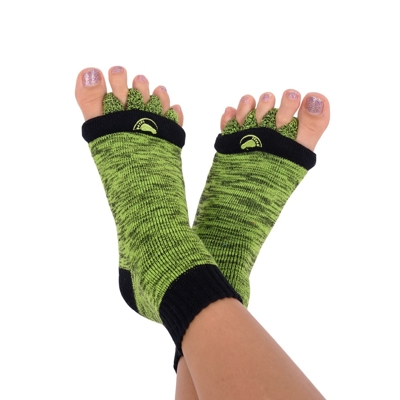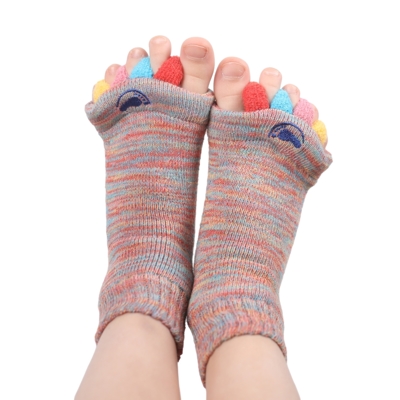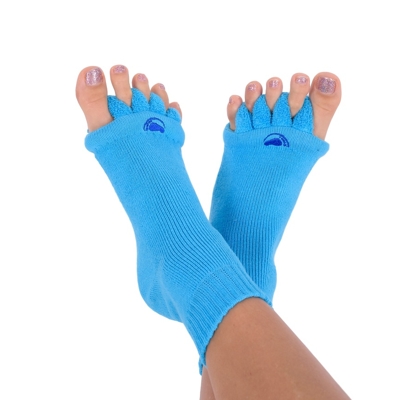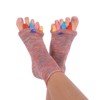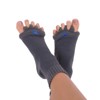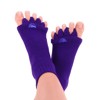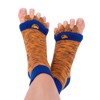It is mostly children's feet we deal with, but the biggest challenge for us are the parents, say paediatric physiotherapists Veronika Studničná and Edita Knotková
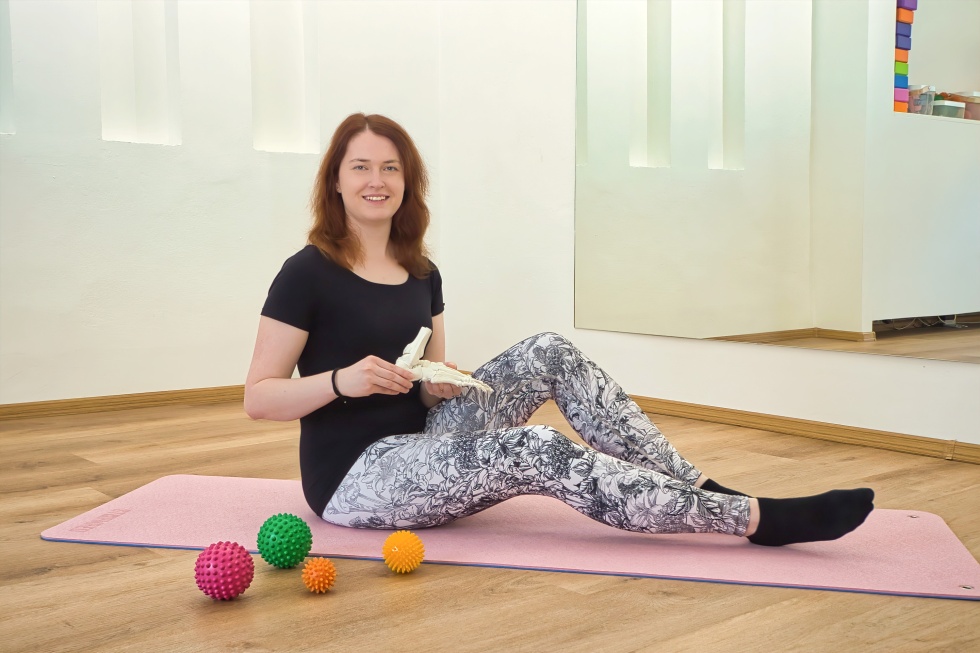 The ideal individual exists only in textbooks. The term individual approach is often used, but it is doubly true in paediatric physiotherapy. The role of parents is crucial in the development of the child. Veronika Studničná is a paediatric physiotherapist who works in a private physiotherapy centre in Prague with children from birth through to the age of 18. Edita Knotková is a physiotherapist who is currently on parental leave, and specialises mainly in prevention, babies and mothers after birth and, last but not least, children of preschool age. We had a nice chat with the two physiotherapists, who have become very good friends, about their work with children, their views on development, and we also got onto the subject of Foot Alignment Socks.
The ideal individual exists only in textbooks. The term individual approach is often used, but it is doubly true in paediatric physiotherapy. The role of parents is crucial in the development of the child. Veronika Studničná is a paediatric physiotherapist who works in a private physiotherapy centre in Prague with children from birth through to the age of 18. Edita Knotková is a physiotherapist who is currently on parental leave, and specialises mainly in prevention, babies and mothers after birth and, last but not least, children of preschool age. We had a nice chat with the two physiotherapists, who have become very good friends, about their work with children, their views on development, and we also got onto the subject of Foot Alignment Socks.
Can you tell us more about your physiotherapy practice and why you decided to work with paediatric patients?
Veronika:
Studying physiotherapy was not my first choice and I got into it in a roundabout way. After failing to enrol for a course in general medicine, I went on to do a bachelor's degree in molecular biology and the biochemistry of organisms, but I missed working with people.
While studying physiotherapy I fell in love with developmental kinesiology and the introduction to the Vojta method. The more work experience I had in standard hospital wards and adult outpatient clinics, the less I wanted to work in such facilities. I found it much more meaningful to help paediatric patients and make their journey through life easier.
I was very lucky to get a summer internship at a children's hospital after my 2nd year, where I met Edita. I was so impressed with her approach that I started working at the hospital after I'd graduated. And it was Edita who gradually got me into working with infants. We got on well together both at work and outside it, and became friends. In 2023, I changed jobs and Edita became a mother. However, we had big plans for the future, which is why we set up the Instagram profile mamimi_fyzio.

Edita:
Like Verča, I didn't go into physiotherapy straight after grammar school. A failed application to study general medicine gave me a year to realise that I needed more contact with people than just five minutes during an examination. I decided to embark on a career in physiotherapy.
I like to say that I was a Motol student through and through. I did my BA and MA there, as well as the Vojta method. It had always been my dream to work with babies, but achieving this has been a long and difficult journey - over two years in an adult outpatient clinic and an intensive care unit until I came to work in a children's hospital. It was only there that I learned that the sooner you start working on a movement problem, the less it develops. That's when I managed to get into the Vojta course and baby therapy.
My professional dream has come true with my son, who has given me a wonderful insight into what it is like to be a parent and helped me put my knowledge into practice. That's why I know that it is necessary to also work with mothers and the family as a whole. A happy baby needs a happy mum.
What are the most common situations or problems you encounter in your practice and how do you approach those challenges?
Veronika:
When working with infants, I most often encounter deviations in psychomotor development, such as delays and a lack of symmetry. In children who can already walk on their own, we most often dealt with the feet. Parents come to use saying their child has pigeon toes or is duck footed, has overpronated ankles, knock-knees, and so on.
The biggest challenge for me is working with the parents. Nowadays, we often see things in black and white, with nothing in between. I’m very glad that today, thanks to many other colleagues, information is relatively easily available on what ideal development should be like. But we have to accept that we’re not all the same and the ideal individual exists only in textbooks. Parents then feel under a great deal of pressure, get lost in all the information, and are often scared of mishandling their child and causing a serious problem.
In my practice, I place a lot of emphasis on explaining to parents what we are focusing on in therapy, why we are doing it and what outcome we expect. In my experience, if everything is explained calmly to the parents without anyone getting too emotional and the next course of action is outlined, it often calms them down. Including in cases when the baby really shows some unusual behaviour. As a Bobath therapist, I've learned that there is no such thing as a stupid question, because the answer to it is important to the person asking it.
Edita:
I most often encounter concerns about the proper motor development of the baby. Most mothers I meet are educated and know how a baby should develop - that's another reason why they want to address the problem early. Many times I find that just slightly changing the way they handle the baby resolves the problem. At other times, a more targeted response is necessary, or I refer the baby for therapy.
I find that physiotherapy can alleviate some seemingly non-physiotherapeutic problem - massive reflux in babies or things such as constipation. I consider the mother’s physical condition to be important. She mustn't be in pain when handling her baby - and that needs to be resolved too.
In walking children, feet are also a common reason for parents to "book their child in". That's what parents often notice first. Knock-knees or bow legs, overpronation, pigeon toes or inadequate clearance. I take an individual approach to each child. It is always absolutely essential for me that the parent understands the nature of the problem and how to resolve it. I try to take a kind approach, but unfortunately I cannot avoid having to be strict if the child has a more serious problem. However, a parent must always understand why we choose a particular course of treatment and therapy.

What impact do you think physiotherapy has on children's development from birth to adulthood, and what role do parents play in this process?
Veronika:
Psychomotor development could be compared to building a house. The child learns new skills and builds more and more on top of them. If the foundations are good, we are more likely to build a level, stable house that will not easily be destroyed. However, if we use exactly the same building stones (bricks, mortar) but stack them on top of each other however we fancy, we cannot expect the upper floors to be stable. For Harry Potter lovers, I’d liken the result to the Weasley family home. Therefore, the sooner the problem is addressed, the better.
On the other hand, I have to say that if we do not look after our bodies, even the best development from birth to walking independently will not save us. In the future, we’d like to start a prevention programme for children in nursery schools, drawing attention to the fact that walking independently is not the be all and end all, and that movement and exercise are very important for children. The percentage of obese children in the population is increasing significantly and it is not true that COVID is to blame for this situation; rather that the pandemic revealed a long-term problem.
The role of the parents is crucial in this process, as they’re the ones who exercise with the child at home. Each course of therapy should be tailored to the individual patient, but also to the patient's family. I'm interested in what their daily routine is, whether they have other children or are caring for a sick grandmother, and where best to schedule therapy within the day so that it interferes as little as possible with their household routine.
"The physiotherapist, parent and child should form a close-knit team that shares the same goal."
If I dictate an A4 list of everything the parents have to do, from moving furniture to exercising at precise times and with a precise number of repetitions, they won't be able to keep up with that and the therapy won't have the desired effect. The physiotherapist, parent and child should form a close-knit team that shares the same goal. In some cases, unfortunately, therapy comes last, as the family situation does not allow for at the time. We encounter all sorts of life stories and we should always be the ones to lend a helping hand, look for solutions and, most importantly, not judge anyone.
Edita:
I’d like to rephrase this question to what effect exercise, not physiotherapy, has on human development. As physiotherapy only addresses movement problems, a healthily developing child does not need physiotherapy - just plenty of varied exercise. And this is where the role of parents is crucial, to set an example to their children showing that exercise is a natural part of their lives.
I always try to explain to the parents how movement control works and how to start - always as gently as possible and to adapt the therapy to their daily routine. I see parents as a kind of guide through the child's life. And I try to make sure that they understand therapy as a shared journey aimed at improving movement and that they know the possible results of our efforts.
What motivated you to start the (mamimi_fyzio) Instagram profile and what information do you try to share with parents and people in this field?
Veronika:
We're happy to admit that neither of us are fans of social media, and we're not very good at it. During our time together at the children's hospital, we had the opportunity to help improve the procedures. One of these projects involved talks for parents who came in to accompany their children. More and more, we said there was a need to improve parental awareness and focus on prevention.
And thanks to that, in spring 2023, we set up the mamimi_fyzio profile. Our posts are focused on topics we often encounter in the outpatient clinic, or various ‘aha moments’ that we’ve taken away from professional courses. Our aim is to provide up-to-date and relevant information, while keeping common sense in mind. We try not to say ‘you mustn’t do this’ or ‘you must do that’, but to show the advantages and disadvantages of the options, so that everyone can then make an informed decision for themselves. It's up to our followers to say if we're doing a good job.

What was your first experience with Foot Alignment Socks and what made you decide to try them?
Veronika:
I first noticed Foot Alignment Socks on the physiobeskyd_edu Instagram profile hosted by physiotherapist Veronika Kristková. I’ve been to several professional courses organised by their physiotherapy facility and have a great deal of respect for her and her colleague Tomáš Zemánek.
I hesitated for quite a long time over whether or not to try Foot Alignment Socks, mainly because I don't have any major foot problems myself. However, after six months or so I took the plunge and ordered a pair to try them out. I don't sit around much at home as we don't have a TV, so I put them on right away for the night. I slept in them for about 4 hours and then took them off. In the morning I felt how light and relaxed my feet were, as if I’d just had a foot massage. I raved about them so much that my husband confiscated them the very next day, saying that he had a bunion and definitely needed them more than I did. And that's how it started. During the first month I bought three more pairs for my husband, mother and sister.
So, what do you see as the main benefits of Foot Alignment Socks and how do you think they differ from other forms of therapy?
Veronika:
I've had the opportunity to see several silicone toe correctors and for me, the big benefit is that Foot Alignment Socks are cotton and don't stick to the skin. This also means they can be machine washed. They can be good in preventing the development of any major difficulties in people whose feet are under a lot of strain. Such as in a job where you’re standing/walking all day long. Not to mention jobs that require a certain dress code (heels for women, half-shoes for men).
They’re also a great relief for athletes who have to wear special sports shoes that are not always an anatomical fit (skates, skates, boots, dance shoes...). And then we can use them in physiotherapy to complement active exercise or to reduce foot pain caused by heel spurs, during pregnancy, etc.
Can you tell us about any specific cases where you’ve seen positive results with Foot Alignment Socks?
Veronika:
So far, I’ve been testing Foot Alignment Socks mostly on myself and family members. Since January, however, they've been a regular lifesaver after a visit to the theatre or a ball. For the last 3 years I’ve been walking almost exclusively in barefoot shoes and when I wear pumps once in a while, my feet suffer a lot.
We’re so happy to have received several pairs from you to show our patients and I look forward to seeing what they have to say about them.
What advice would you give to parents looking to support their children in physiotherapy, especially when it comes to preventative care?
Veronika:
That’s a very difficult question. First of all, I’d advise them not to be put off by the claim that the child will grow out of it. Yes, the hip or leg as such develops up to early school age and the condition can right itself. However, no one can guarantee that this will happen with your child. Anyone who claims it will is at best drawing on statistics, or at worst just making it up.
If parents are unsure about anything, it’s better if they consult us. It’s not always necessary to exercise right away. Sometimes it’s enough to modify movement habits and add some appropriate sports and exercise. and then check up on the condition once in a while. I dare say that most paediatric physiotherapists have no shortage of patients, and if they’re wise, they won’t make extra work for themselves where it’s not needed.
From my point of view, it’s important for parents to get on with the physiotherapist on a personal level, too. As I mentioned earlier, the physiotherapist, parent and child should form a close-knit team with the same goal in mind. Parents shouldn't be afraid to ask questions or admit that they’re not good at something. We’re there for them and we put our heads together to seek a way to make it work.



